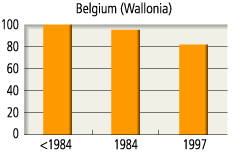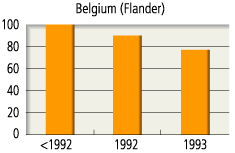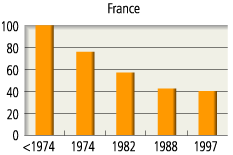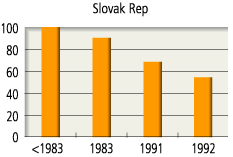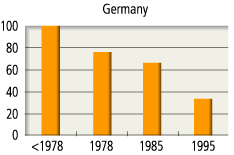I. Title of the Best Practice
Thermal Regulation for New Buildings
II. Overview of the Best Practice
A. Characteristics of the measure
1. Objectives
The energy consumption for space heating or air conditioning of buildings (dwellings or commercial buildings) is a major part of energy consumed -and CO2 emissions- in developed countries. The conception of the building will greatly determine the energy consumption during its lifetime and the constructor does not spontaneously take into account the best equilibrium between cost of construction and cost related to energy consumed for space heating (paid by the occupant). Since the first oil shock in 1973, most countries have implemented thermal buildings regulation for new buildings in order to improve energy efficiency in space heating and air conditioning. Taking in account the rate of construction the impact of the measure is mainly relevant at long term.
2. GHG targeted
Through energy efficiency, the CO2 emissions are reduced.
3. public targeted
Thermal regulations are mandatory measures applying to all conceptors and constructors of buildings. The energy consumed by tenants of these buildings is optimized, limiting the CO2 emissions of residential and commercial sectors.
4. Design of the measure
The thermal regulation of buildings implemented in France is designed through a global approach of optimization with an obligation of results (in term of energy consumption) while in some countries regulation is designed through an obligation of means (standards on the components of buildings).
The first regulation was edicted for dwellings in 1974 and the level was strengthened in 1982 and 1988. For commercial buildings the first regulation was adopted in 1976 and strengthened in 1988. The new dwellings constructed after 1988 consumed less than half of the average consumption of dwellings constructed before 1974.
The objective of the regulation is to optimize the whole cost of buildings (investment and operating costs). Energy consumptions are computed by the constructor in order to ensure a temperature of 19oC inside the building. The <<global>> approach makes the constructor able to choose on which component or function of the building he want to increase the energy efficiency (windows, insulation of blind walls, heating system and boiler...) to reach the mandatory performance.
Several computing methods are available for constructors, from a very simple one based on minimal individual technical solutions (selection of performant components) to more sophisticated ones (taking into account thermal losses, solar energy inputs, prices of different energies).
B. Reasons for inclusion as a Best Practice
The interest of thermal building regulation relies in the relative simplicity of the measure and the good acceptability among stake-holders. This measure is typically a non regret measure since the buildings are designed to minimize the global cost.
The evaluation of the French energy efficiency policy showed that, if the behaviors of tenants have stayed identical at those of 1973 and without thermal regulation in dwellings, residential energy consumption should have been in 1996 higher than the observed consumption by +30% (+ 17,4 Mtoe/year). Globally, despite the increase of the number of dwellings and the enhancement of comfort (increase in the share of central heating), the total consumption of energy of the residential sector had decreased slightly (- 2.9%) during the period.
Each steps of regulation after 1974 (1982 and 1988) was prepared with the professionals of construction in order to assess the best technologies commercially available and the state of the art of the construction methods. Before the 1988 regulation step, labels had been implemented in order to accelerate the penetration of more efficient technologies than the current level of regulation (labels gave an access to preferential interest rates through loans contracted by owners). Demonstration projects of efficient buildings were also supported by public means.
The initial over-cost of investment (between 5 to 15%) due to the requirements of the regulation was rapidly absorbed through the dissemination of new technologies and the learning process in the practices of constructors.
The evaluation of the measure (done in 1996) stated that it would have been more efficient to mix the global approach (in term of optimization of results) with standards on some components like windows, glasses and boilers. Then the regulation would have benefited also to the refurbishing of existing buildings. The evaluation stresses also the importance of the control of the regulation especially for small constructors of individual houses.
This measure, implemented in almost all developed countries had demonstrated to be very efficient despite various methodologies of designing the regulation. A study conducted for the World Energy Council by ADEME identified the efficiency of the measure in several countries :
Influence of Energy Efficiency Standards in new buildings
Index 100 of energy consumption per square meter in buidings
|
